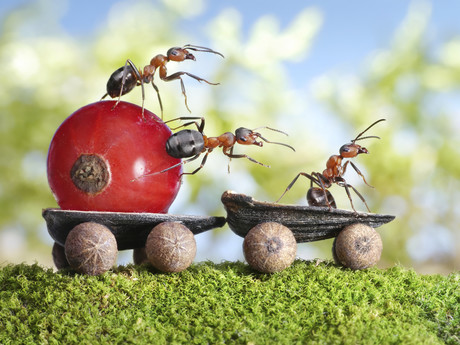How ants get their bearings

Their brains may be smaller than the head of a pin, but ants are excellent navigators that use celestial and terrestrial cues to memorise their paths. Now, an international research team has shown that ants can get their bearings whatever the orientation of their body, proving that insect brains are much more complex than previously thought.
Ethological research has previously suggested that ants memorise the scenery perceived along their route as it is projected on their multifaceted retinas, thus using a body-centred, or egocentric, frame of reference. By this hypothesis, to recognise memorised surroundings and follow a path formerly travelled, ants would need to orient their bodies in the same way each time.
The problem with this theory is that ants sometimes need to walk backwards, and this doesn’t prevent them from finding their way back to their nest. So how are ants able to recognise a route when facing the opposite direction? To answer this question, the researchers studied Cataglyphis velox, an Andalusian desert ant known for its solo navigation ability.
The researchers let a group of ants familiarise themselves with a route that included a 90° turn, before providing each ant with either a small or a large cookie crumb to handle. Those who received a cookie crumb light enough to carry whilst walking forwards handled the turn without difficulty. Those given large cookie crumbs had to move backwards and, unlike the others, maintained their bearing instead of turning.
After walking backwards a bit, members of the second group of ants would occasionally drop their crumb, turn around, observe the scenery while pointing their body in the right direction, return to the crumb, and resume towing it backwards — but this time in the correct direction. Thus, despite body alignment seeming necessary for the recognition of scenery perceived by their retinas, the ants were able to memorise the new bearing and follow it backwards. They could also recall the existence of the dropped cookie crumb, and its location, in order to return to it after updating their bearing. These observations point towards at least three kinds of memory working in unison: the visual memory of the route, the memory of the new direction to follow and the memory of the crumb to retrieve.
Through another experiment using a mirror to reflect the sun, the team demonstrated that the ants used celestial cues to maintain their bearing while walking backwards. Furthermore, the ants were able to move in straight paths whether walking forwards, backwards or sideways. Once a bearing was memorised, they stayed on it no matter how their bodies were oriented. These observations suggest that ants register direction using an external — or allocentric — frame of reference.
The researchers concluded that ants’ spatial orientation relies on multiple mental representations and memories woven together through a flow of information between several areas of their brain. The results of their study can be read in the journal Current Biology.
Babies of stressed mothers likely to get their teeth earlier
Maternal stress during pregnancy can speed up the timing of teeth eruption, which may be an early...
Customised immune cells used to fight brain cancer
Researchers have developed CAR-T cells — ie, genetically modified immune cells manufactured...
Elevated blood protein levels predict mortality
Proteins that play key roles in the development of diseases such as cancer and inflammation may...





